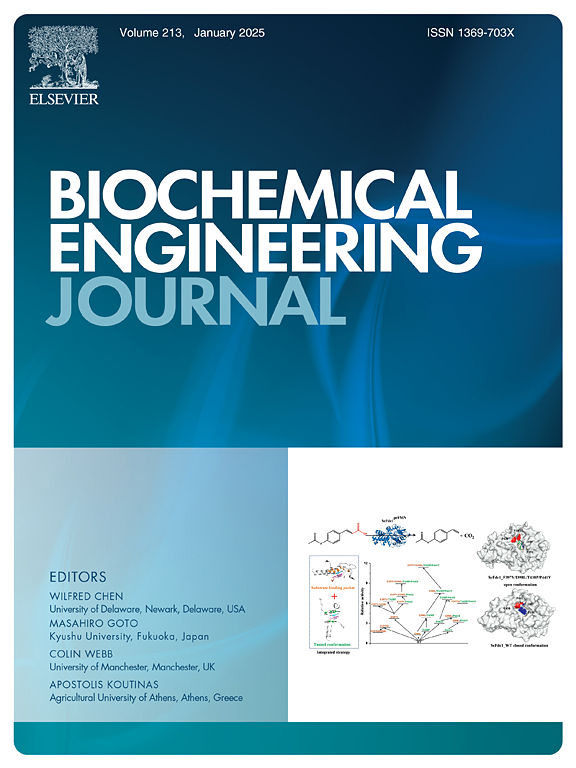改进的喷淋器提高了含砷金精矿在搅拌槽中的生物浸出效果
IF 3.7
3区 生物学
Q2 BIOTECHNOLOGY & APPLIED MICROBIOLOGY
引用次数: 0
摘要
生物浸出常用于低品位矿石,混合应变浸出受温度和基质等因素的影响。本研究比较了中温菌和亲热菌的协同浸出效果,包括氧化亚铁钩端螺旋体(L. f)、酸性钙硫杆菌(A. c)和热硫氧化硫杆菌(S. t)。确定了(L. f + A. c): S. t = 1:1的有效应变组合。随后,用纳米曝气管(NAP)取代了原来的分散器,以研究其影响。结果表明,NAP显著提高了反应体系的吸氧速率(OUR)和体积传质系数(kLa)。此外,通过对浸出样品中胞外聚合物(EPS)含量的分析和微生物群落的评估,表明改进的分散剂(NAP)提高了EPS含量,改变了生物浸出过程中的优势菌群。浸出效率提高3.61 %,日能耗降低1.59 %。扫描电镜也证实了NAP对微生物浸出的促进作用。该研究不仅提高了浸出效率,显示了经济潜力,而且为优化生物浸出搅拌池技术提供了新的视角。本文章由计算机程序翻译,如有差异,请以英文原文为准。
The improved sparger enhances bioleaching of arsenic-bearing gold concentrate in a stirred tank
Bioleaching is frequently applied to low - grade ores, and mixed - strain leaching can be influenced by factors such as temperature and substrates. This study compared the cooperative leaching effects of mesophilic and thermophilic strains, including Leptospirillum ferrooxidans (L. f), Acidithiobacillus caldus (A. c), and Sulfobacillus thermosulfidooxidans (S. t). An efficient strain combination of (L. f + A. c): S. t = 1:1 was identified. Subsequently, the original sparger was replaced with a nano - aeration pipe (NAP) to investigate its impact. Results indicated that NAP considerably elevated the oxygen uptake rate (OUR) and volumetric mass transfer coefficient (kLa) within the reaction system. Moreover, by analyzing the extracellular polymeric substances (EPS) content in leaching samples and assessing the microbial community, it was shown that the improved sparger, namely NAP, increased EPS content and altered the dominant bacterial groups in bioleaching. Leaching efficiency rose by 3.61 %, while daily energy consumption fell by 1.59 %. Scanning electron microscopy also confirmed that NAP enhanced microbial leaching. This study not only improves leaching efficiency and demonstrates economic potential but also offers a novel perspective for optimizing stirred - tank technology in bioleaching.
求助全文
通过发布文献求助,成功后即可免费获取论文全文。
去求助
来源期刊

Biochemical Engineering Journal
工程技术-工程:化工
CiteScore
7.10
自引率
5.10%
发文量
380
审稿时长
34 days
期刊介绍:
The Biochemical Engineering Journal aims to promote progress in the crucial chemical engineering aspects of the development of biological processes associated with everything from raw materials preparation to product recovery relevant to industries as diverse as medical/healthcare, industrial biotechnology, and environmental biotechnology.
The Journal welcomes full length original research papers, short communications, and review papers* in the following research fields:
Biocatalysis (enzyme or microbial) and biotransformations, including immobilized biocatalyst preparation and kinetics
Biosensors and Biodevices including biofabrication and novel fuel cell development
Bioseparations including scale-up and protein refolding/renaturation
Environmental Bioengineering including bioconversion, bioremediation, and microbial fuel cells
Bioreactor Systems including characterization, optimization and scale-up
Bioresources and Biorefinery Engineering including biomass conversion, biofuels, bioenergy, and optimization
Industrial Biotechnology including specialty chemicals, platform chemicals and neutraceuticals
Biomaterials and Tissue Engineering including bioartificial organs, cell encapsulation, and controlled release
Cell Culture Engineering (plant, animal or insect cells) including viral vectors, monoclonal antibodies, recombinant proteins, vaccines, and secondary metabolites
Cell Therapies and Stem Cells including pluripotent, mesenchymal and hematopoietic stem cells; immunotherapies; tissue-specific differentiation; and cryopreservation
Metabolic Engineering, Systems and Synthetic Biology including OMICS, bioinformatics, in silico biology, and metabolic flux analysis
Protein Engineering including enzyme engineering and directed evolution.
 求助内容:
求助内容: 应助结果提醒方式:
应助结果提醒方式:


